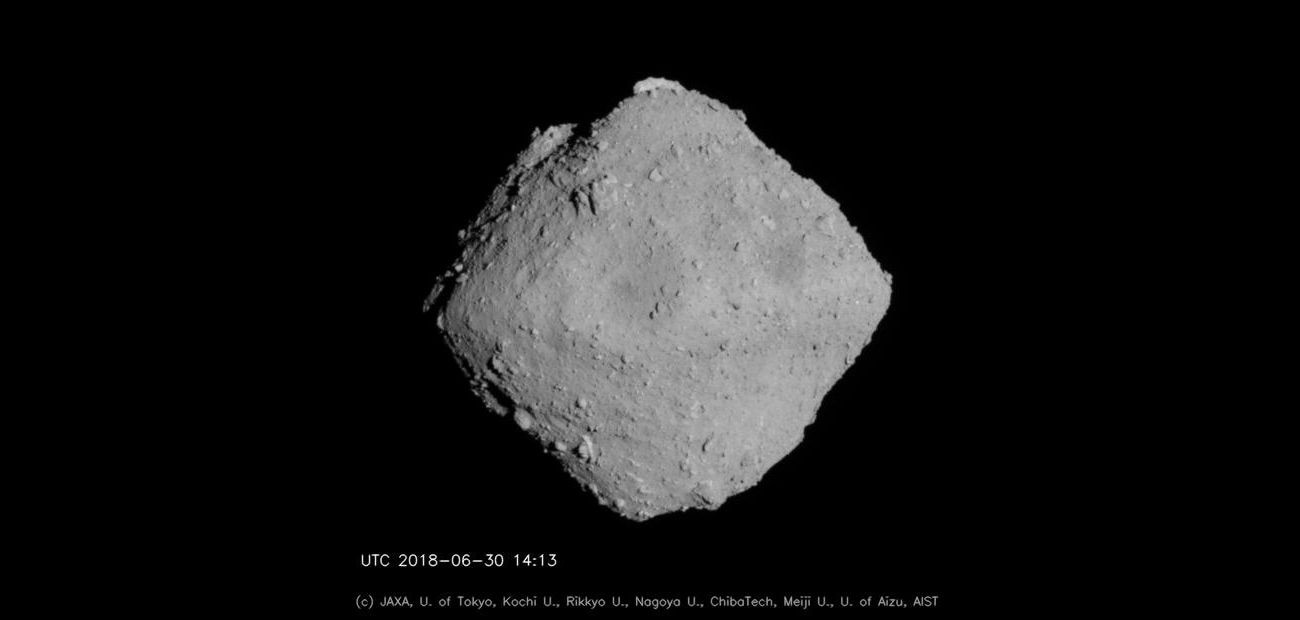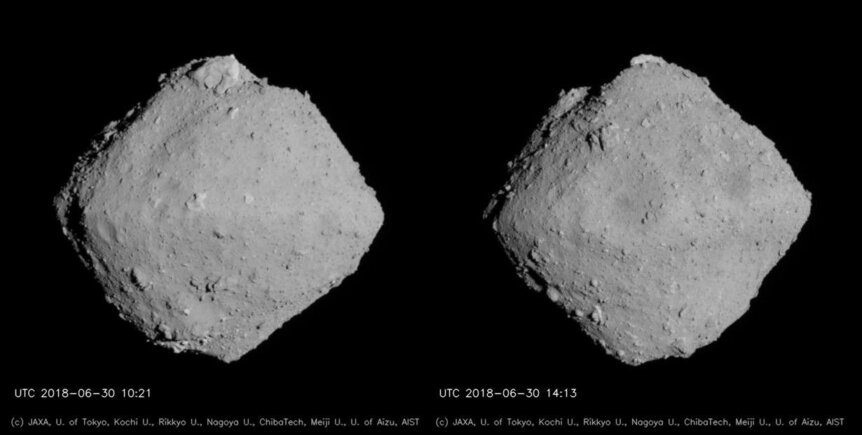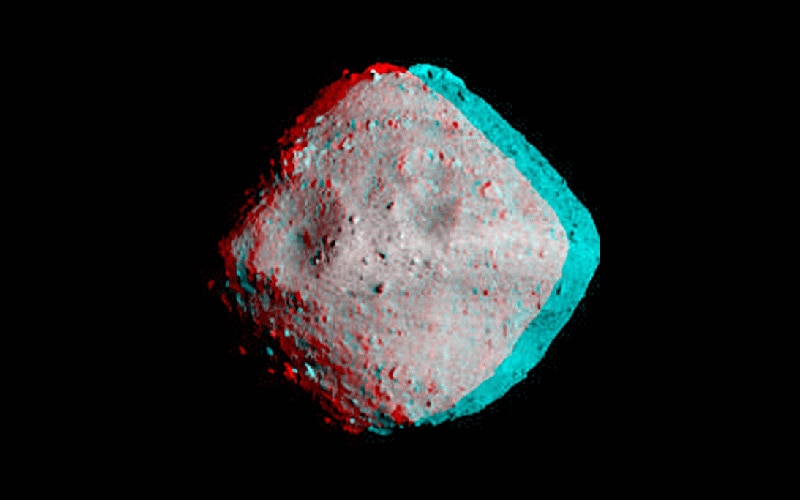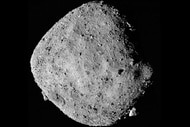Create a free profile to get unlimited access to exclusive videos, sweepstakes, and more!
Ryugu, front to back

On June 27, 2018, the Japanese spacecraft Hayabusa 2 entered orbit around an asteroid, making it only the fourth probe to accomplish such a feat (the others are NEAR Shoemaker, the first Hayabusa, and NASA's Dawn mission, which has orbited both Ceres and Vesta, though they are more properly protoplanets than asteroids).
The asteroid is called Ryugu, and it's only about 900 meters across, roughly half a mile. Hayabusa is currently about 20 kilometers from the rock, and is still being tested out; engineers with the Japanese space agency JAXA are "confirming instrument operations" now, making sure everything is working according to specs.
After achieving orbit, they released an image of Ryugu from 40 km, but last week they released two more taken from 20 km, so presumably with twice the resolution (twice the ability to see details, since that depends on distance for a given camera). The two images were taken a little under four hours apart; since Ryugu rotates every 7.5 hours, the asteroid rotated halfway around between shots. This means we're seeing one side in one image, and the other side in the second: Nearly the whole rock is covered in these two images!
If I've done the math right, and just playing with some likely numbers for the volume and mass for Ryugu*, the orbital velocity of Hayabusa 2 is about 3.5 centimeters per second. That's slow. At 20 km out from the asteroid, it takes about 40 days to circle it once! So in the few hours between these two exposures Ryugu rotated halfway around, while the spacecraft hardly moved at all. That's why the Sun appears to be coming from the same direction in both shots (note the shadows; the Sun is behind Hayabusa 2 and slightly to the right in both).
A lot is noticeable right away. As I wrote in a previous article, the surface looks grainy, not like a solid rock. Many asteroids are not solid, but are instead "rubble piles," basically a bag of rocks held together by their own gravity. Slow speed collisions with other small asteroids over billions of years have shattered it in place, cracking it and pulverizing it without breaking it up. What's left is, well, what you see. Big rocks, small rocks, pebbles and smaller, all sitting there together.
By the way, Dr. Brian May (yes, that Brian May) created a nice stereoscopic image of Ryugu using these two images, if you have red/green anaglyph glasses.
There is what looks like a very large boulder lodged into the surface near the north pole (the top of the image). You can see most of it in the earlier image, and it just sticks up high enough to peek over the edge in the later image. It may be the biggest boulder on the surface; another one located about halfway down from the pole in the later image looks to be slightly smaller. By eye (well, measuring it in the image) it's about 100 meters across, the size of an American football field. That gives an interesting scale to Ryugu!
The Sun angle makes it hard to see shadows, so there's not much to give our eyes contrast, but still you can see some craters. The big one near the equator seen in the image from 40 km out is there in the second image, but it’s so fuzzy it's a little hard to see. A few other craters are seen near the edges, including one roughly 100 meters wide on the left edge of the first image, and others here and there. It looks to me like there might be a decent one at the south pole (bottom), but it's hard to tell. The terrain (asteroidain?) near the north pole is lumpy, too, and that might be a big crater near the boulder. Or just a chunk of Ryugu blown off by a grazing impact. I'm guessing! Hopefully as more images come in showing it from different angles, and the sunlight comes from different directions, we'll get a better idea of what we're seeing here.
As we saw in the earlier image, the craters almost without exception have smooth, humpy rims, again just what you'd expect from a rubble pile and not from a solid, monolithic surface. I'm very curious to learn what physical parameters (like mass and density) Hayabusa 2 determines for Ryugu!
It wasn't clear from the image from 40 km away, but some of the craters have smooth floors, too, implying (at this resolution) they're filled in a bit, perhaps with dust. Gravity on Ryugu is pretty light, but it's enough to get some flow of material. Every time it gets hit by a smaller rock, that can shake Ryugu and cause material to flow, for example.
Remember, too, these are images taken from some distance away. Once decent maps are made, planetary scientists and engineers will find suitable locations for the multiple landers currently stowed on board to set down. Then we'll start to see some really cool shots! And then there's the ultimate goal: grabbing some samples of the surface and returning them to Earth in late 2020!
Oh, what we'll learn about asteroids then. But that's not for quite some time. Plenty to do at Ryugu first.
*Ryugu is shaped like two right cones bottom to bottom. The volume of a right cone is 1/3 x pi x (radius of base)2 x height. If Ryugu’s polar radius is the same as its equatorial one, that simplifies to 1/3 pi r3. Multiply by 2 to account for both hemispheres, and you get a volume of 200 trillion cubic centimeters. If the density is about 2 grams per cubic centimeter (I'm guessing it's loose rubble, so that should be close) the mass is 400 trillion grams. The orbital speed of a satellite around an object is sqrt (G x mass / r), where G is Newton's Universal Gravitational Constant, 6.68 x 10-8 cm3 g−1 s−2, and r is the orbital distance, 20 km. If you wanna check my math, feel free.
















